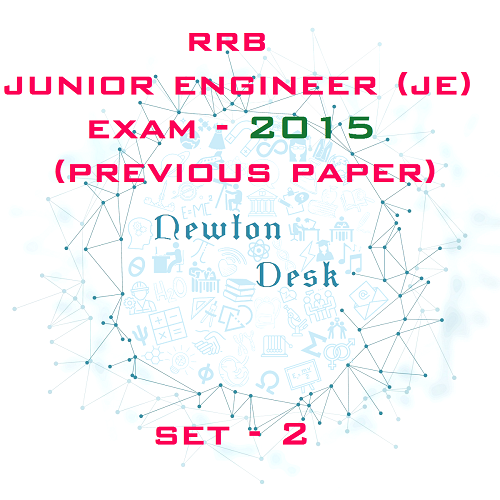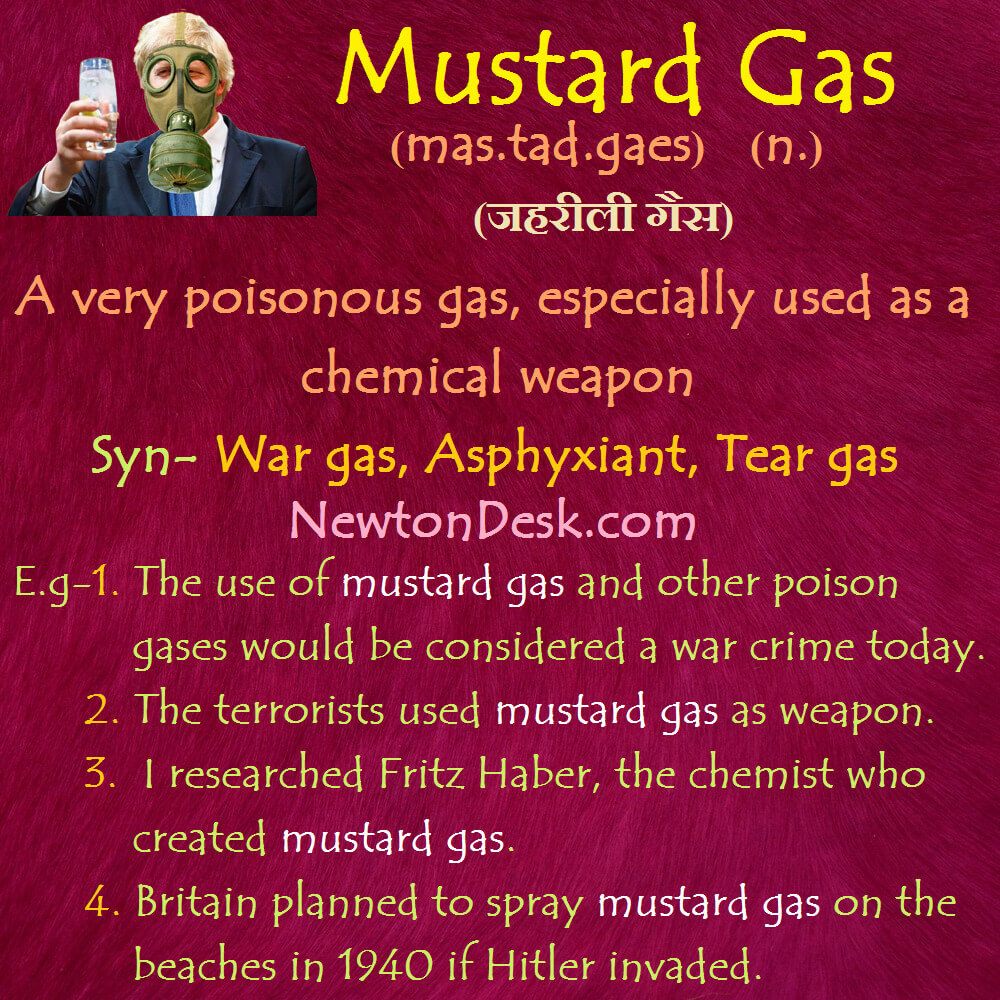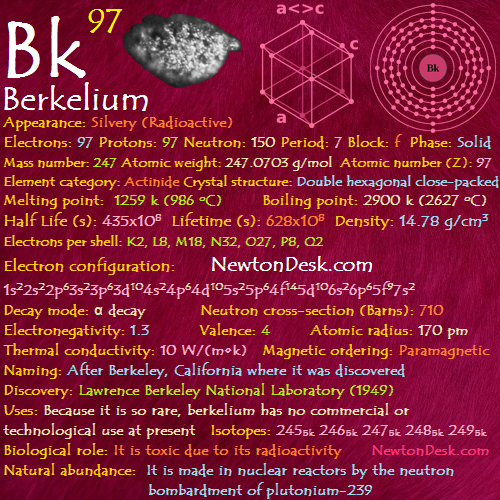ssc je mechanical question paper
#sscjemechanical #sscje2018
SSC Junior Engineer Exam Paper – 2018 “held on 23 January 2018” Morning Shift (Mechanical Engineering)
Q 1: How many types of ecological pyramids are present In ecosystem ?
Options:
1) Spring
2) Screw
3) Wedge
4) Pulley
Answer: Spring
Q 2: What are the numbers of binary and ternary links the following kinematic chain ?
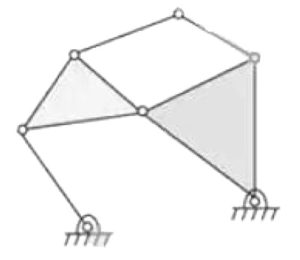
Options:
1) 3 binary and 4 ternary joints
2) 3 binary and 3 ternary joints
3) 3 binary and 2 ternary joints
4) 4 binary and 2 ternary joints
Answer: 4 binary and 2 ternary joints
Q 3: How many degrees of freedom does the below mechanism have ?
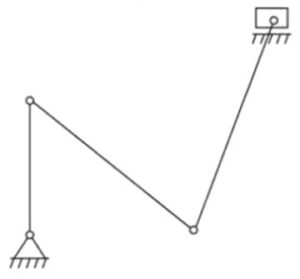
Options:
1) 0
2) 1
3) 2
4) 3
Answer: 2
Q 4: Which of the following is TRUE for four bar mechanism ?
Options:
1) All sliding pairs
2) One is sliding pair and other is turning pair.
3) All turning pairs
4) None of these
Answer: All turning pairs.
Q 5: Which of the following is the CORRECT method for the conversation of spring controlled governor from unstable to stable ?
Options:
1) Increasing the ball weight
2) Decreasing the spring stiffness.
3) Decreasing the ball weight
4) Increasing the spring stiffness.
Answer: Increasing the spring stiffness.
Q 6: The power transmission takes place in shaft rotating at 400 rpm and this rotating shaft drives another shaft at 600 rpm. The smaller pulley has the diameter of 0.5 m. The centre distance between pulleys is 4m. If the angle of contact on the smaller pulley for the open belt drive is 1.8o then calculate the diameter or larger pulley (in mm) and angle of contact (in rad) ?
Options:
1) 0.50 and 2.00
2) 0.75 and 2.00
3) 0.50 and 3.08
4) 0.75 and 3.08
Answer: 0.75 and 3.08
Q 7: Which of the following statement is CORRECT about the bull engine ?
Options:
1) Obtained by fixing the cylinder or sliding pair.
2) Obtained by fixing the crank.
3) Obtained by fixing the piston rod.
4) None of these
Answer: Obtained by fixing the cylinder or sliding pair.
Q 8: Which of the following condition is CORRECT about the Inversion of a mechanism ?
Options:
1) Conversion of higher pair to lower pair
2) Turning it upside down.
3) Obtained by fixing different links in a kinematic chain.
4) Obtained by reversing the input and output motion of the mechanism.
Answer: Obtained by fixing different links in a kinematic chain.
Q 9: Which of the following statement is INCORRECT about the dry clutch and wet clutch ?
Options:
1) Heat dissipation is more difficult in dry clutch.
2) Rate of wear is very less in wet clutches as compared to dry clutches.
3) Torque transmitting capacity of dry clutch is less than wet clutch.
4) Engagement in wet clutch is smoother than dry clutch.
Answer: Torque transmitting capacity of dry clutch is less than wet clutch.
Q 10: Which of the following theory is/are used for the determination of torque quantities in cone clutch ?
Options:
1) Uniform pressure theory
2) Uniform strain theory
3) Uniform stress theory
4) None of these
Answer: Uniform pressure theory OR Uniform strain theory
Q 11: Which of the following toothed wheels does not come under the classification according to the type of gearing ?
Options:
1) External gearing
2) Internal gearing
3) Rack and Pinion
4) Parallel gearing
Answer: Parallel gearing
Q 12: The profile of the gears is involute with 200. If the length of the path of approach and length of path of recess are 28 mm and 25 mm respectively. What is the length of arc of contact ? (cos20o = 0.94)
Options:
1) 54
2) 54.4
3) 56
4) 56.4
Answer: 56.4
Q 13: The governor in which the displacement of the sleeve is high for the small change of speed is known as______.
Options:
1) Hunting
2) Sensitive
3) Stable
4) Isochronous
Answer: Sensitive
Q 14: The point of contact which is common between the two pitch circles is known as______.
Options:
1) Base point
2) Addendum
3) Dedendum
4) Pitch point
Answer: Pitch point
Q 15: The tensile strength for the plate per pitch length of the outer row of the rivet is______.
Options:
1) Pt = (p – d)tσt / 2
2) Pt = 2(p – d)tσt
3) Pt = (p – d)tσt
4) Pt = (p – d)t2σt
Answer: Pt = (p – d)tσt
Q 16: Choose the option which is INCORRECT about the term friction.
Options:
1) Friction produces heat
2) It leads to the decrease in the velocity of object
3) It leads to the increase in the velocity of object
4) It can stop the moving object
Answer: It leads to the increase in the velocity of object
Q 17: Which of the given formula is CORRECT for calculating the angle of static friction ϕS ?
Options:
1) tan-1μs
2) sin-1μs
3) cos-1μs
4) None of these
Answer: tan-1μs
Q 18: Which of the following statement is CORRECT for the modulus of resilience ?
Options:
1) It is the ratio of maximum stress energy and unit volume.
2) It is the ratio of maximum strain energy and unit volume.
3) It is the ratio of proof resilience and unit volume
4) It s the ratio of proof resilience and unit area.
Answer: It is the ratio of proof resilience and unit volume
Q 19: Calculate the value of modulus of elasticity (N/mm2), if the Poisson’s ratio is 0.25 and modulus of rigidity of the material is 80 N/mm?
Options:
1) 100
2) 200
3) 250
4) 300
Answer: 200
Q 20: Which of the following is CORRECT option for validation of Hooke’s law in simple tension test ?
Options:
1) Ultimate stress
2) Breaking Point
3) Elastic Limit
4) Limit of proportionality
Answers: Limit of proportionality
Q 21: A steel rod whose diameter is 2 cm and is 2 m long, experiences heating from 30oC to 150oC. The coefficient of thermal expansion is α = 12 x 10-8 / oC and the rod has been restricted in its original position. The thermal stress developed is 288 Mpa. What is the value of Young’s modulus (GPa) ?
Options:
1) 50
2) 100
3) 150
4) 200
Answer: 200
Q 22: Choose the INCORRECT conditions for the thermal stress in a body.
Options:
1) It is the function of coefficient of thermal expansion.
2) It is the function of temperature rise.
3) It is the function of modulus of elasticity.
4) It is the function of modulus of rigidity.
Answer: It is the function of modulus of rigidity.
Q 23: The formula for the Euler’s buckling load is given as π2EI / 4L2. This is RUE for which of the following columns ?
Options:
1) Column with one end fixed and other end free.
2) Column with one end fixed and other end hinged.
3) Column with both ends fixed.
4) Column with both hinged ends.
Answer: Column with one end fixed and other end free.
Q 24: Determine the shape of the elastic curve between the supports B and C for the beam as shown in the figure below.
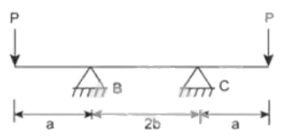
Options:
1) A straight line
2) Elliptical
3) Parabolic
4) Circular
Answer: Parabolic
Q 25: The elongation (mm) in a steel bar having a square cross section of dimension 40 mm x 40 mm is 2.5 mm and is subjected to an axial compressive load of P (KN). If the length of the bar is 4 m and modulus of elasticity is E = 250 GPa. What is the value of P (KN) ?
Options:
1) 100
2) 150
3) 200
4) 250
Answer: 100
[sociallocker]
Q 26: The property of a material states that it is rigid. The value of Poisson’s ratio for this particle is_____.
Options:
1) 0
2) 1
3) 2
4) None of these
Answer: 0
Q 27: Consider the loaded beam as shown in the figure below
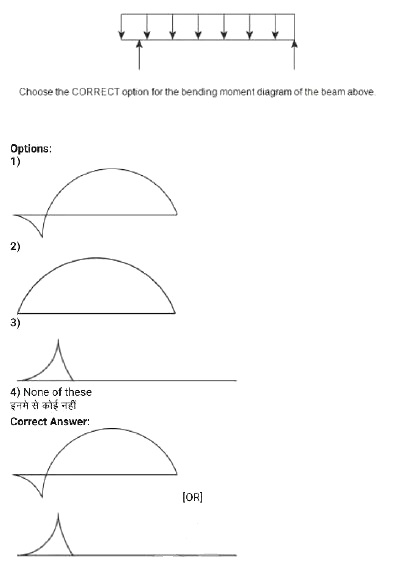
Q 28: Calculate the total angle of twist for a stepped shaft which is subjected to the torque (T) as shown in the figure below.

Options:
1) TI / πGd4
2) 66TI / πGd4
3) TI / 66Gd4
4) 36TI / πGd4
Answer: 66TI / πGd4
Q 29: A cross sectional bar of area 700 mm2 is subjected to an axial load as shown in the figure below what is the value of stress (MPa) in the section QR ?

Options:
1) 30
2) 40
3) 50
4) 60
Answer: 40
Q 30: Choose the CORRECT equation which defines the relationship between the Young’s Modulus (K) and Poisson’s ratio (u).
Options:
1) E=3K(1-2u)
2) E=3K(1-u)
3) K=3E(1-2u)
4) K=3E(1-u)
Answer: E=3K(1-2u)
Q 31: In a P-V diagram for pure substance, the constant temperature line in superheated region is_______.
Options:
1) Converging
2) Diverging
3) Intersecting
4) Parallel
Answer: Diverging
Q 32: Which equation clearly defines the entropy change during the isothermal process for a system with m kg of gas at pressure P1, volume V1, temperature T1 and entropy s1 is heated to state points of pressure P2, volume V2, temperature T2 and entropy s2 ?
Options:
1) mcvln(T2 / T1)
2) mcpln(T2 / T1)
3) mRln(V2 / V1)
4) 
Answer: mRln(V2 / V1)
Q 33: The entropy change of the system and the surroundings during a process between two equilibrium states is ________.
Options:
1) Equal to zero
2) Greater than zero
3) Less than zero
4) Greater than or equal to zero
Answer: Greater than or equal to zero
Q 34: A Carnot heat pump is used to maintain a room at a temperature of 30oC, the initial temperature of the room was 30oC. If the power requirement of the pump is 20KW. What is the heat pumped (in kW) to the room ?
Options:
1) 3
2) 17
3) 154
4) 174
Answer: 174
Q 35: Which equation best represents the net entropy change (s) for an irreversible process ?
Options:
1) s = 0
2) s = 1
3) s < 0
4) s > 0
Answer: s > 0
Q 36: Which of the engine has a spark plug used for igniting the fuel ?
Options:
1) Petrol engine
2) Diesel engine
3) Steam engine
4) Gas engine
Answer: Petrol engine
Q 37: What happens to the efficiency, when the temperature of intake air is lowered in an I.C engine ?
Options:
1) Increases
2) Decreases
3) Remains same
4) Increases to a certain limit, then decreases
Answer: Increases
Q 38: For a process which is non-flow (U is the internal energy, Q is the heat and W is the work done) the first law of thermodynamics states______.
Options:
1) ∂U = ∂Q – ∂W
2) 
3) 
4) ∂U = ∂Q
Answer: 
Q 39: Which equation represents the steady flow system ?
Options:
1) H1 + (V12 / 2gJ) + (z1 / J) + Q = (V22 / 2gJ) + (Z2 / J) + Losses
2) H1 + (V12 / 2gJ) + (z1 / J) + Q = (V22 / 2gJ) + (Z2 / J) + Losses + workdone
3) H1 + (V12 / 2gJ) + (z1 / J) + Q = H2 (V22 / 2gJ) + (Z2 / J) + Losses + workdone
4) H1 + (V12 / 2gJ) + (z1 / J) = H2 (V22 / 2gJ) + (Z2 / J) + Losses + workdone
Answer: H1 + (V12 / 2gJ) + (z1 / J) + Q = H2 (V22 / 2gJ) + (Z2 / J) + Losses + workdone
Q 40: In a P-T diagram for pure substance, the melting line has highest inclination with respect to the positive horizontal axis representing temperature for which type of substance ?
Options:
1) Substance that contracts on freezing
2) Substance that expends on freezing.
3) Substance that has same volume on freezing.
4) None of these
Answer: Substance that expends on freezing.
Q 41: Which of the following graphs represents working of an ideal Diesel cycle on p-V scale ?

Q 42: The work done by a system is 45kJ. If the internal energy of the system is decreased b 15 kJ. What is the heat received (in kJ) by the system ?
Options:
1) –60
2) –30
3) 30
4) 60
Answer: 30
Q 43: A reversible adiabatic in a T-S diagram is a________.
Options:
1) Point
2) Vertical line
3) Horizontal line
4) Parabolic curve
Answer: Vertical line
Q 44: Specific enthalpy is an________of a system and its unit is______.
Options:
1) Extensive propert, kJ
2) Extensive property, kJ/kg
3) Intensive property, kJ
4) Intensive property, kJ/kg
Answer: Intensive property, kJ/kg
Q 45: The internal energy of the system is a function of temperature only U=30+0.5t kJ. If the system does the work of o.5 kJ/k. What is the increase in heat interaction per degree temperature ?
Options:
1) – 1
2) 0
3) 1
4) Cannot be determined
Answer: 1
Q 46: 2500 kJ/min heat is supplied to a heat engine at 727oC. It rejects heat at 900 kJ/min at 223oC. This type of engine is________.
Options:
1) Ideal
2) Irreversible
3) Impossible
4) Practical
Answer: Impossible
Q 47: What happens to the COP of a heat pump, when the temperature difference between source and sink is decreased ?
Options:
1) Decreases
2) First decreases, then increases
3) First increases, then decreases
4) Increases
Answer: Increases
Q 48: If two Carnot engine CE1 and CE2 are connected in a series such that the heat rejected by CE1 is used as the input for the CE2 cycle with the intermediate temperature being the geometric mean of the extreme temperatures. Which of the following statement is TRUE for this efficiency of the Carnot engine ?
Options:
1) ηCE1 > ηCE2
2) ηCE1 < ηCE2
3) ηCE1 = ηCE2
4) Insufficient data
Answer: ηCE1 = ηCE2
Q 49: what type of slopes does constant pressure line have in the superheated region of the Moiler diagram ?
Options:
1) Positive slope
2) Negative slope
3) Zero slope
4) First positive than negative slope
Answer: Positive slope
Q 50: For a gas with n degree of freedom, what will be the value of cp / cv ?
Options:
1) n+1
2) n–1
3) 1–2 / n
4) 1+2 / n
Answer: 1+2 / n
SSC Junior Engineer All Previous Papers (www.newtondesk.com)
Q 51: With which of the following age hardening is related ?
Options:
1) Cast iron
2) Gun metal
3) Duralumin
4) German Silver
Answer: Duralumin
Q 52: Monel metal is an alloy of
Options:
1) Cu and Cr
2) Ni and Cu
3) Ni and Cr
4) Cu, Ni and Cr
Answer: Ni and Cu
Q 53: ______ Iron is the magnetic allotrope of iron.
Options:
1) α
2) β
3) γ
4) δ
Correct Answer: α
Q 54: The bonding of a rubber sheet with a metal is done by
Options:
1) Welding
2) High frequency dielectric heating
3) Induction welding
4) Adhesive bonding
Answer: Adhesive bonding
Q 55: Plain and butt welds may be used on materials upto approximately
Options:
1) 25 mm thick
2) 40 mm thick
3) 50 mm thick
4) 75 mm thick
Answer: 25mm thick
Q 56: An optical gauge works on the principle of
Options:
1) Reflection of light rays
2) Polarisation of light rays
3) Interference of light rays
4) Refraction of light rays
Answer: Interference of light rays
Q 57: Generally, the strongest from in which metals can be used as
Options:
1) Hot rolling
2) Cold rolling
3) Extrusion
4) Forging
Answer: Forging
Q 58: Thermite is a mixture of
Options:
1) Five aluminium and iron oxide in the ratio of 3:1
2) Five iron and aluminium oxide in the ratio of 3:1
3) Five aluminium and iron oxide in the ratio of 3:1, with traces of sulphur, phosphorus and manganese
4) Molten iron and aluminium, with the ratio depending upon the type of the surface to be welded
Answer: Five aluminium and iron oxide in the ratio of 3:1
Q 59: The process of enlarging a hole is known as
Options:
1) Counter boarding
2) Counter sinking
3) Boring
4) Drilling
Answer: Boring
Q 60: Which of the following statements is true ?
Options:
1) Crater wear is predominant In ceramic tools
2) Crater wear is predominant in carbon tool steel
3) Crater wear is predominant In tungsten carbide tools
4) Crater wear is predominant in high speed steel tools
Answer: Crater wear is predominant In tungsten carbide tools
Q 61: The bomb calorimeter is an apparatus to measure the
Options:
1) Calorific value of a gaseous fuel
2) Calorific value of solid and gaseous fuels
3) Calorimetric composition of any soli bomb material
4) Calorific value of a solid or liquid fuel
Answer: Calorific value of a solid or liquid fuel
Q 62: In metric system the unit of heat is given as
Options:
1) CHU
2) BTU
3) kcal
4) Kelvin
Answer: kcal
Q 63: Centrifugal pump is an example of
Options:
1) Isolated system
2) Closed system
3) Steady flow system
4) None of these
Answer: Steady flow system
Q 64: A refrigeration system works on
Options:
1) Second law of thermodynamics
2) First law of thermodynamics
3) Zeroth law of thermodynamics
4) None of these
Answer: Second law of thermodynamics
Q 65: Liquids have
Options:
1) No specific heat
2) Different values of specific heat at same temperature
3) Only one value of specific heat
4) Two distinct values of specific heat
Answer: Only one value of specific heat
Q 66: The volume of the universal gas constant (Ru) is equal to
Options:
1) 848 m kgf.kg.mol / K
2) 8.48 m kgf/kg-mol / K
3) 84.8 m kgf/kg-mol / K
4) 0.848 m kgf/kg-mol / K
Answer: 848 m kgf.kg.mol / K
Q 67: The solid fuel having the highest calorific value is
Options:
1) Wood
2) Lignite
3) Coke
4) Anthracite
Answer: Anthracite
Q 68: The heat transfer Q, the work done W and the change in Internal energy U are all zero in the case of
Options:
1) A rigid vessel containing steam at 150oC left in the atmosphere which is at 25oC
2) 1 kg of gas contained in an insulated cylinder expanding as the piston moves slowly outwards.
3) A rigid vessel containing ammonia gas connected through a value to an evacuated rigid vessel, the vessel, the value and the connecting pipes being well insulated and the valve being opened and after a time, condition through the two vessels becoming uniform
4) 1 kg of air flowing adiabatically from the atmosphere Into a previously evacuated bottle
Answer: A rigid vessel containing ammonia gas connected through a value to an evacuated rigid vessel, the vessel, the value and the connecting pipes being well insulated and the valve being opened and after a time, condition through the two vessels becoming uniform
Q 69: A reversible engine operates between temperatures T1 and T2. The energy rejected by this engine is received by a second reversible engine at temperature T2 and rejected to a reservoir at temperature T3. If the efficiencies of the engines are same then , the relationship between T1, T2, and T3 is given by
Options:
1) T2 = (T1 + T3) / 2
span style=”color: #000000; font-size: 10pt;”>2) T2 = sqrt {(T1)2 + (T3)2}
3) T2 = sqrt (T1 * T3)
4) None of these
Answer: T2 = sqrt (T1*T3)
Q 70: Efficiency of a Carnot engine is 75%. If the cycle direction is reversed, COP of the reversed Carnot cycle is
Options:
1) 1.33
2) 0.75
3) 0.33
4) 1.75
Answer: 0.33
Q 71: The channel section considered to have the highest efficiency is
Options:
1) Quadrant
2) Square
3) Trapezoid
4) Triangular
Answer: Trapezoid
Q 72: Any liquid flow, obeys the following
Options:
1) Capillary action
2) Bernoulli’s equation
3) Continuity equation
4) Newton’s law of viscosity
Answer: Continuity equation
Q 73: According to principle of floatation, the weight of liquid displaced as compared to the weight of the body is
Options:
1) More
2) Less
3) Same
4) Depending upon the shape of the body
Answer: Same
Q 74: The wetted perimeter for a pipe running full of water is equal to: Where d is the diameter of the pipe.
Options:
1) πd / 2
2) 2πd
3) πd
4) δ
Answer: πd
Q 75: Metacentric height is the distance between
Options:
1) CG of body and centre of pressure
2) CG of body and the metacentre
3) CG of body and centre of buoyancy
4) None of these
Answer: CG of body and the metacentre
SSC Junior Engineer All Previous Papers (www.newtondesk.com)
Q 76: Surface tension is caused by the force of _______at the free surface.
Options:
1) Cohesion
2) Adhesion
3) Both cohesion and adhesion
4) None of these
Answer: Cohesion
Q 77: The intensity of pressure in a liquid due its depth will, vary with depth.
Options:
1) Directly
2) Indirectly
3) Both directly and directly
4) None of these
Answer: Directly
Q 78: The metacentric height of sailing ships is
Options:
1) 0.45 m to 1.25 m
2) 1.5m to 3.5m
3) 0.25 m to 0.35m
4) 5m to 7.5m
Answer: 0.45 m to 1.25 m
Q 79: The discharge through a pipe can be measured with
Options:
1) A venturimeter
2) An orificemeter
3) A flow nozzle
4) All option are correct
Answer: All option are correct
Q 80: According to Nikuradse’s the boundary behaves hydrodynamically smooth when
Options:
1) (k/δ) > 10
2) (k/δ) > 0.25
3) (k/δ) < 0.25
4) (k/δ) < 8
Answer: (k/δ) < 0.25
Q 81: The coefficient of friction in term or Reynold’s number is
Options:
1) 16/Re
2) 32/Re
3) 8/Re
4) 10/Re
Answer: 16/Re
Q 82: The maximum velocity of an airplane in steady level flight will occur at an angle of attack of
Options:
1) 20.5o
2) 18.5o
3) 22.5o
4) 26.5o
Answer: 20.5o
Q 83: The wave produced due to surface tension in a shallow channel is known as
Options:
1) Gravity wave
2) Capillary wave
3) Elastic wave
4) None of these
Answer: Capillary wave
Q 84: Which one of the following is an axial flow turbine ?
Options:
1) Pelton wheel
2) Francis turbine
3) Kaplan turbine
4) None of these
Answer: Kaplan turbine
Q 85: The unit power of a turbine is equal to
Options:
1) P / H5/2
2) P / H1/2
3) P / H3/2
4) P / H2/5+1/2
Answer: P / H3/2
Q 86: Pseudo plastic is a fluid for which
Options:
1) Dynamic viscosity decreases as the rate of shear increases
2) Newton’s law of viscosity holds good
3) Dynamic viscosity increases as the rate of shear increases
4) Dynamic viscosity increases with the time for which shearing forces are applied
Answer: Dynamic viscosity increases as the rate of shear increases
Q 87: Match List I with List II and Select the correct answer using the codes given below the lists.
| List – 1 | List – 2 | ||
| A | Lubrication | 1 | Capillary |
| B | Rise of sap in trees | 2 | Vapour Pressure |
| C | Formation of droplets | 3 | Viscosity |
| D | Cavitation | 4 | Surface tension |
Options:
1) A-2, B-4, C-1, D-3
2) A-3, B-4, C-1, D-2
3) A-2, B-1, C-4, D-3
4) A-3, B-1, C-4, D-2
Answer: A-3, B-1, C-4, D-2
Q 88: Centrifugal pumps have which of the following advantages ?
1) Low initial cost
2) Compact, occupying less floor space
3) Easy handling of highly viscous fluids
Options:
1) 1, 2 and 3
2) 1 and 2
3) 1 and 3
4) 2 and 3
Answer: 2 and 3
Q 89: What is the unit of dynamic viscosity of a fluid termed ‘poise’ equivalent to ?
Options:
1) Dyne / cm2
2) gs / cm
3) dyne-s / cm2
4) g-cm / sec
Answer: dyne-s / cm2
Q 90: Which one of the following conditions will linearize the Navier – Stokes equations to make It amenable for analytical solutions ?
Options:
1) Low Reynolds number (Re << 1)
2) High Reynolds number (Re >> 1)
3) Low Mach Number (M << 1)
4) High Mach Number (M >> 1)
Answer: Low Mach Number (M << 1)
Q 91: Which of the following advantages is/are possessed by a Kaplan turbine over a Francis turbine ?
1) Low frictional losses
2) Part load efficiency is considerably high
3) More compact and smaller in size
Select the correct answer using the codes given below.
Options:
1) Only 1
2) 1 and 2
3) 2 and 3
4) 1, 2 and 3
Answer: 1, 2 and 3
Q 92: The stream function Ψ=x3-y3 is observed for a two dimensional flow field. What is the magnitude of the velocity at point (1, -1) ?
Options:
1) 4.24
2) 2.83
3) 0
4) -2.83
Answer: 4.24
Q 93: Non uniform flow occurs when
Options:
1) The direct and magnitude of the velocity at all points are identical
2) The velocity of successive fluid particles, at any point, is the same at successive periods of time
3) The magnitude and direction of the velocity do not change from point to point in the fluid
4) Velocity, depth, pressure etc, change from point to point in the fluid flow.
Answer: Velocity, depth, pressure etc, change from point to point in the fluid flow.
Q 94: The length of divergent portion of venturimeter in comparison to convergent portion is
Options:
1) Same
2) More
3) Less
4) More or less depending on capacity
Answer: More
Q 95: In order that flow takes place between two points in a pipeline, the differential pressure between these points must be more than
Options:
1) Frictional force
2) Viscosity
3) Surface friction
4) All option are correct
Answer: All option are correct
Q 96: Head developed by a centrifugal pump depends on________.
Options:
1) Impelier diameter
2) Speed
3) Fluid density
4) Both impeller diameter and speed
Answer: Both impeller diameter and speed
Q 97: Low specific speed of turbine implies it is
Options:
1) Propeller turbine
2) Francis turbine
3) Impulse turbine
4) None of these
Answer: Impulse turbine
Q 98: The figure given below shows the relationship between power (P) and discharge (Q) for different vane exit angles of centrifugal pump. In the figure given below, curve B holds good for.
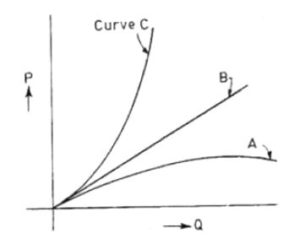
Options:
1) Vane exit angle of 90o
2) Vane exit angle of less than 90o
3) Vane exit angle of more than 90o
4) Any vane exit angle
Answer: Vane exit angle of 90o
Q 99: The specific speed of a turbine is the speed of such a turbine, Identical with a given turbine, which
Options:
1) Develops unit power under unit head
2) Develops unit power under unit discharge
3) Develops unit speed under unit head
4) Delivers unit discharge under unit head
Answer: Develops unit power under unit head
Q 100: In reaction turbine
Options:
1) Kinetic energy is appreciable as the fluid leaves the runner and enters draft tube
2) The vanes are partly filled
3) Total energy of fluid is converted to kinetic energy in the runner
4) It is not exposed to atmosphere
Answer: It is not exposed to atmosphere.
[/sociallocker]
SSC Junior Engineer All Previous Papers (www.newtondesk.com)
